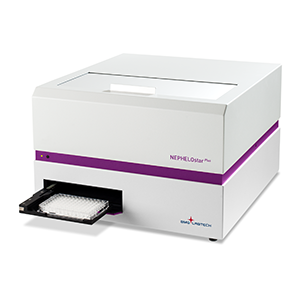Nephelometric Microplate Readers that Measure Light-Scattering
The NEPHELOstar Plus uses light-scattering to measure the turbidity or solubility of a sample in a microplate based environment. This nephelometric microplate reader offers the HTS/ Drug Screening laboratory an easy to use, low cost, and rapid method for checking the solubility of compounds. The flexibility and performance of the NEPHELOstar Plus allows more applications to be adapted to light-scattering than ever before.
NEPHELOstar Plus applications include:
- Determination of compound solubility
- Microbial growth kinetics monitoring
- Precipitation and polymerization monitoring
The NEPHELOstar Plus microplate nephelometer detects insoluble particles in liquid samples by measuring forward scattered light. It uses a laser beam that is directed through the solution and it can detect the scattered light at angles of up to 80 degrees. The NEPHELOstar Plus can be up to thirty times more sensitive than traditional transmission readers that measure the reduction in direct light passing through a sample well via optical density.
Turbidity
The measurement of turbidity, which is the haziness or cloudiness of a fluid that sometimes cannot been seen by the naked eye, can be used to determine the amount of insoluble particles in a solution. Amongst the life science applications that can use turbidity measurements include: drug compound solubility, bacterial or fungal growth studies, immunoprecipitations, protein aggregation, antibody-antigen interaction, and polymerization monitoring.Turbidity measurements can also be performed with a nephelometric instrument that measures light-scattering, such as the NEPHELOstar Plus from BMG LABTECH. This instrument uses a diode laser that passes light through each sample. If there are insoluble particles in the solution, the laser light will be scattered by the particles. Similar to absorbance measurements, the amount of scattered light is directly proportional to the amount of particles in solution. However, light-scattering measurements do not suffer from the same upper limitation as absorbance measurements, thereby providing a wider dynamic range for turbidity measurements.
